- Home
- Culture of India
- Indian Paintings
- Miniature Painting
Miniature Painting
Miniature Paintings:
Miniature paintings are small sized handmade paintings that can be traced back to 6th and 7th century. However it got prominence and developed during medieval period.
Miniature paintings derived its name from minimum or red lead which was used during medieval period. Earlier it was done on Palm leaves and later it was started on paper.
The Pala dynasty of India are considered as the pioneer
in this art later on it reached to the peak during the Mughal period.
With delicate brush work, graceful forms and natural bright colors miniature paintings are so beautiful and graceful that even to this day it is in great demand.
The
paintings also have stone dust, real gold and silver dust to make it more
decorative and beautiful. Usually the themes used are from the epics of
Ramayana, Mahabharata, Bhagavatha and stories of Lord Krishna and Radha.
History of Miniature Painting
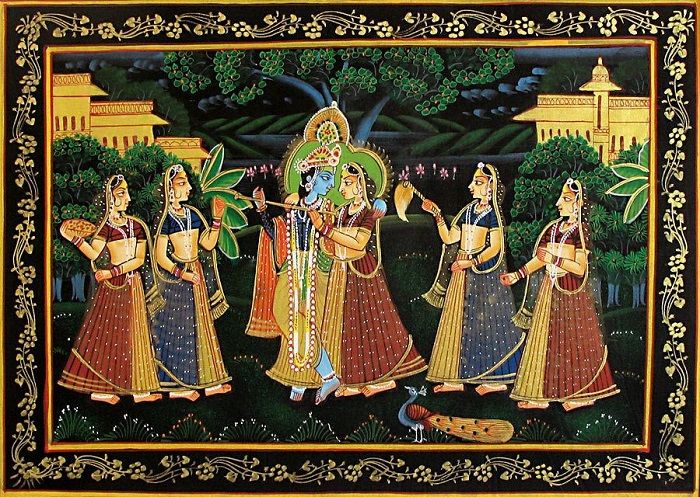
In the Indian history the art can be traced back to Pala period. It is understood that the origin of Miniature paintings was around 750 AD when Palas started to rule the eastern part of India and to the western part of India was the Chalukya's.
Most of the teachings of Buddha were written on palm leaves. Even the Buddhist text Prajnaparamita has paintings of micro and miniature size.
Jainism encouraged
the miniature paintings in the Western part of India all along Rajasthan,
Gujarat and Malwa. Jain manuscripts have paintings with bright colors and bold
lines.
With the
beginning of Persian influence round 15th century palm leaves were
replaced by paper and various hunting scenes were introduced. The golden period
of miniature paintings was during the Mughal period. The art reached its zenith
during Akbar period which ultimately gave rise to Mughal painting.
This also led
to the development of important school of painting like Mughal, Rajput and
Deccan. The miniature paintings further got refined under the influence of
European style of painting. During Aurangzeb period many miniature artists
moved to different places. Thus Rajput miniature painting developed around 17th
and 18th century.
Rajasthani
miniature paintings mostly centred on the Lord Krishna and Radha and other
Hindu Mythological epics like Ramayana and Mahabharata. Another important style
that developed during Rajput's was Pahari style in the mountainous region of
Jammu to Himachal Pradesh. With the presence of many school miniature paintings
steadily different across India and is still very famous in India.
Schools of Miniature Paintings
Pala School of Painting
The earliest
school of miniature painting is the Pala School of Painting. It belonged to as
early as 8th century. Some of the earliest examples of miniature
paintings are the Buddhists texts and monasteries of Nalanda, Odantapuri and
Somarupa which were the centres for learning art.
Most of the
Pala rulers followed Buddhism and a large number of Buddhists manuscripts are
written on palm leaf with images of Buddhists deities at the centre and the
other part is completely covered with small paintings. The best surviving
example of the Pala illustrated manuscripts belonged to Vajrayana school of
Buddhism.
The themes usually were Buddhists rituals. The colors used were of natural man made colors. Another important about the skill of Pala art was the graceful usage of lines and beautifully filled with colors.
Pala style was natural with different
forms of contemporary bronze and stone sculpture. The Pala art came to a halt
with the invasion of Muslims who destroyed many Buddhists monasteries. Some of
the popular places of Pala art were Sri Lanka, Nepal, Burma, Tibet and many
other places.
Jaina School of Miniature Painting:
It was during 11th century Jaina School of miniature painting gained prominence and importance. The Jain temples and monasteries have the mural paintings which are around 2,000 years old.
The religious manuscript text like the “Kalpa
Sutra” and “Kalkacharya Katha” were described in miniature paintings. Like
other schools even Jaina school had paintings on palm leaves and later on
paper.
Jaina School
used natural and bright colors and real gold and silver dust to depict the
stories in the paintings. Usually the colors used in the paintings were red,
blue, gold and green. The figures in the paintings were usually seen in three
quarter view with protruding nose and eyes.
The paintings were usually of goddess of thirthankaras and male figures and also different incidents of life like marriage and Indra’s marking his forehead are drawn.
The
goddess was very dressed and ornamented. Rishabh the first Thirtankara was
depicted either in lotus position or standing position. Bull images also appear
in the sculptures. During late 16th century these paintings started
to decline.
Orissa School of Miniature Painting
Not much is known about this school of painting. It is believed to have come into existence around 17th century and continued as late as 19th century.
The theme was mostly of Lord Krishna and his Gopis, Radha, Krishna
Leela and Gita Govindam. Even though paper was widely used during 17th
century still palm leaves were used by this school for paintings. Orissa School
used rich colors, heavily ornamented and very expressive.
Mughal School of Miniature Painting:
Mughal School of painting developed largely in the Mughal courts during 16th-18th century. With the amalgamation of Indian paintings and Persian style of Painting which gave rise to Mughal School of Painting.
The Mughal painting
reached its peak during Akbar and Shah Jahan period. This beautiful paintings
spread to other Indian courts as well like that of Hindus and Sikhs. Hindus
started with the miniature paintings on the stories of Ramayana and
Mahabharata.
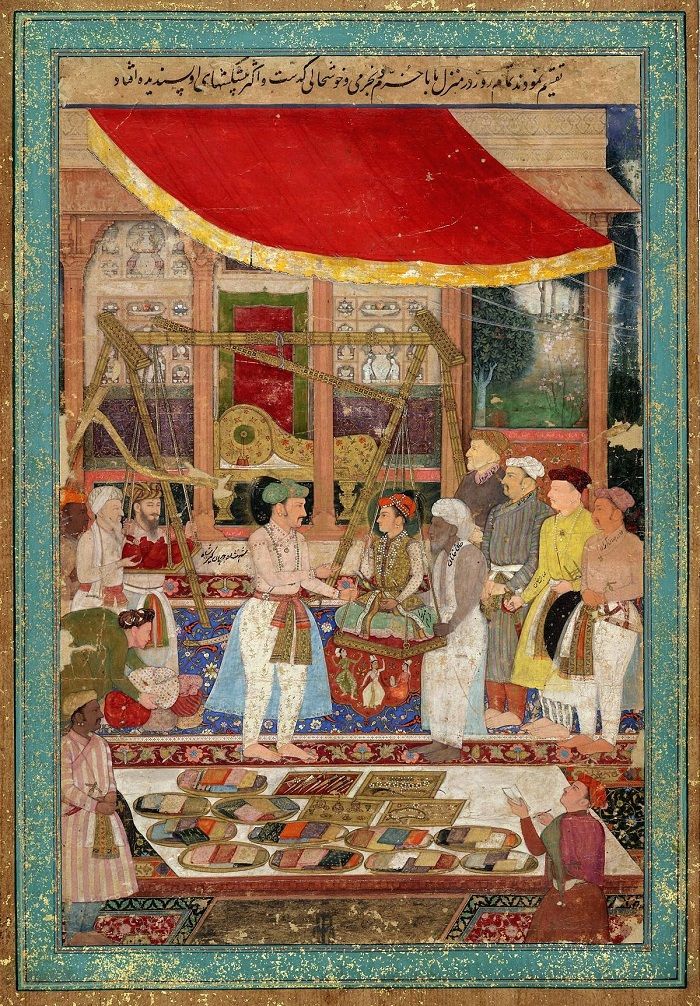
The style of
the Mughal school was started within the royal studio. Initially knowledge was
transformed among the family members. The system of joint manuscripts brought
many artists together for a single work. The seniors artists would usually draw
the outline and the junior artists would fill colors and fill the outer
background.
The theme of Mughal paintings differed from one ruler to other. Some of the famous miniature during Akbar and Shah Jahan period include Tutinama (Tales of Parrot) and Hamzanama. Even during Jahangir period the artists of the manuscript painting got lot of prominence and importance.
During his period the paintings were
mostly of nature, animals and birds. Also a lot of Durbar scenes have been
painted. The art began to deteriorate during Aurangzeb period. Some of the
famous artists include Kamal, Fazi, Basawan, Lal and Daswanath.
Deccan School of Miniature Painting:
This painting
evolved during Bahamani period in the South Western part of India. The style
was developed under Deccan sultanates. The Deccan paintings mostly flourished
in the areas of Bijapur, Golkonda, Ahmednagar, Bidar and Berar. The style of
Deccan school of painting flourished during 16th and 17th
century.
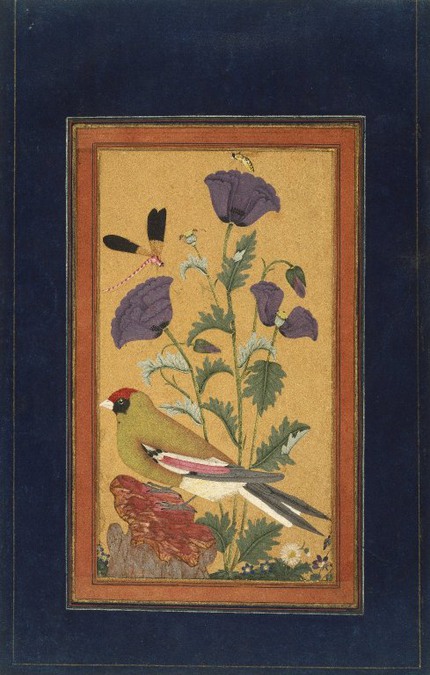
After Mughal
conquered the Deccan the style gradually deteriorated and new style evolved
known as Hyderabad style of painting in the Nizam territory region. The
paintings were in geometrical shapes with large forehead and eyes. Bright
colors like red and orange were used in the painting. The paintings had
multidimensional effect and intense depth in the strokes.
Bijapur paintings were patronized by Ali Adil Shah and by his successor Ibrahim II. The most important miniature painting during this period is the Najum-ul-ulum which has around 400 miniature illustrations. Lepakshi temple has the influence of Bijapur school of painting.
Golcanda
paintings were done during Qutb Shahi. He appointed mostly Persian artists for
the work. Some of the famous work during this period includes Lady with Myna
Bird and Lady with Hooka.
Hyderabad style of painting developed during Asafjahi dynasty. One can see an influence of Mughal style of painting during this period. It was mainly because several artists during Aurangzeb period moved to Deccan as Aurangzeb was not keen in developing the art.
The most important distinctive features during 18th
and 19th century include bright color, ethnic costume, jewellery,
flora and fauna, landscapes. The most common type of painting in Hyderabad
style included princess surrounded by servants.
Pahari School of Miniature Painting:
Pahari school of Painting flourished during 17th to 19th century. It originated in the Himalayan region of Northern part of India, from Jammu to Almora and Garhwal through Himachal Pradesh. The style has its origin from Mughal style of painting.
The pattern and style of paintings were different for different region like bold paintings in Basohli region to delicate paintings in Kangra region.
However the theme remained mostly same with the paintings done
usually of God and Goddess. Pahari painting further gave rise to different
schools like Guler school, Chamba, Basohli, Kangra and Garhwal School.
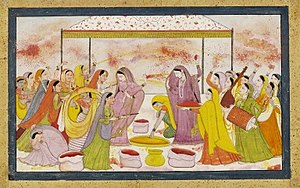
Guler school of Painting: This is the early phase of Kangra painting.
Around 18th century some of the Hindu artists who were trained in
Mughal style took the support of Raja of Guler and developed the style of
painting with delicacy and spirituality of feeling. Usually the themes were
Gita Govinda, Bhagavata, Bihari Satasai and Rangamala.
Chamba School of Painting:
Chamba is
famous for miniature Pahari Paintings. Raja Udai Singh and Raja Jai Singh
patronised this school of painting. Chamba painting has the influence of Mughal
style and has both murals and miniature paintings. The themes were usually of
Hindu religious themes like Shiva Parvati, Rama Darbar, Krishna, Gopis and also
of lord Krishna with Radha. These paintings are displayed in the museums at
Chamba, Shimla and Dharmsala.
Basohli School of Painting:
Basohli is considered as the first school
of Pahari painting which developed under Kangra painting around mid 18th
century. Basohli school is probably pre Mughal origin. Basohli painting used
rich and bold colors.
Kangra School of Painting:
With the fading away of Basohli, Kangra school of painting gained more prominence and importance. The paintings used natural and fresh colors and used various shades. The main theme of this painting was Srinagar and also other themes were Bhagvadgita, Gita Govinda.
In
some of the miniature paintings Lord Krishna is painted blue and is seen
dancing. This style reached its peak during Maharaja Sansar Chand Katoch who
was a great patron of Kangra art.
Rajput Painting
Rajput painting also known as Rajasthani painting flourished under the Rajputana kingdom in India. The style of each Rajputana Kingdom was different however most of the paintings were done on the walls of the palaces, inner chamber of forts and havelis.
The decline in the Mughal paintings gave rise to the
Rajasthani painting. Most of the paintings were on the stories of Ramayana,
royal lifestyle of kings and queens and the legacy of past and the present
rulers.
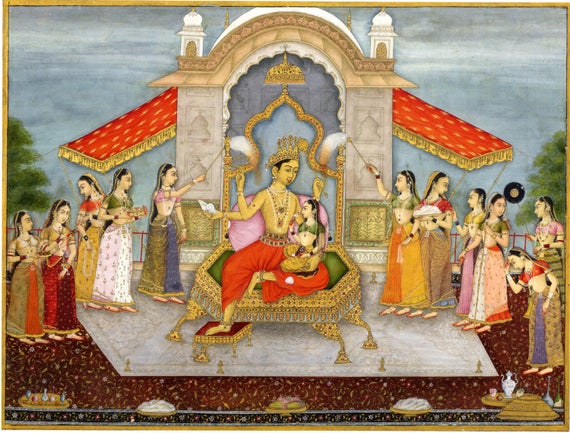
Rajasthani School of painting was further divided into Mewar, Marwar, Hadoti and Dundar school. The colors used were natural; it took almost two weeks to prepare the desired color. The colors were extracted from minerals, plant based and conuch shells.
The artists also used very fine brushes. The art is still present in Rajasthan
and use paper, ivory and silk. Now the natural colors are replaced by
artificial colors.
Check out for other pages
Update on coronavirus in India
Affiliate Disclosure:
If you make any purchase via a link on this site, I may receive a small commission with no added cost to you.


